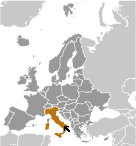World Atlas: Italy. On this page you can see the map, country flag and many detailed information about the people, history and economy of Italy.

Here you can find online selected information about the geography, inhabitants, government, economy and history of Italy. Included are selected statistics, an overview map and the detailed map of Italy. But let's start with the flag of Italy here:
Italy - Overview:
What you should know about Italy? Let's start with this: Italy became a nation-state in 1861 when the regional states of the peninsula, along with Sardinia and Sicily, were united under King Victor Emmanuel II. An era of parliamentary government came to a close in the early 1920s when Benito Mussolini established a Fascist dictatorship. His alliance with Nazi Germany led to Italy's defeat in World War II. A democratic republic replaced the monarchy in 1946 and economic revival followed. Italy is a charter member of NATO and the European Economic Community (EEC) and its subsequent successors the EC and the EU. It has been at the forefront of European economic and political unification, joining the Economic and Monetary Union in 1999. Persistent problems include sluggish economic growth, high youth and female unemployment, organized crime, corruption, and economic disparities between southern Italy and the more prosperous north.
Geography of Italy
 Where on the globe is Italy? The location of this country is Southern Europe, a peninsula extending into the central Mediterranean Sea, northeast of Tunisia. Total area of Italy is 301,340 sq km, of which 294,140 sq km is land. So this is quite a large country. How could we describe the terrain of the country? This way: mostly rugged and mountainous; some plains, coastal lowlands. The lowest point of Italy is Mediterranean Sea 0 m, the highest point Mont Blanc (Monte Bianco) de Courmayeur 4,748 m (a secondary peak of Mont Blanc). And the climate is predominantly Mediterranean; alpine in far north; hot, dry in south.
Where on the globe is Italy? The location of this country is Southern Europe, a peninsula extending into the central Mediterranean Sea, northeast of Tunisia. Total area of Italy is 301,340 sq km, of which 294,140 sq km is land. So this is quite a large country. How could we describe the terrain of the country? This way: mostly rugged and mountainous; some plains, coastal lowlands. The lowest point of Italy is Mediterranean Sea 0 m, the highest point Mont Blanc (Monte Bianco) de Courmayeur 4,748 m (a secondary peak of Mont Blanc). And the climate is predominantly Mediterranean; alpine in far north; hot, dry in south.
Inhabitants of Italy
Let's take a look how many people live in Italy. The number is: 62,137,802 (July 2017 est.). So quite a lot people live here. Who lives here? Italian (includes small clusters of German-, French-, and Slovene-Italians in the north and Albanian-Italians and Greek-Italians in the south). What are the languages in Italy? Italian (official), German (parts of Trentino-Alto Adige region are predominantly German speaking), French (small French-speaking minority in Valle d'Aosta region), Slovene (Slovene-speaking minority in the Trieste-Gorizia area). And the religions: Christian 80% (overwhelmingly Roman Catholic with very small groups of Jehovah's Witnesses and Protestants), Muslim (about 800,000 to 1 million), atheist and agnostic 20%. How old are the people in average? 45.5 years. We have to add that this number is the median - so one half of the people is older than this, one half is younger. And what is their life expectancy (at birth)? This: 82.3 years. Where the people live in Italy? Here: despite a distinctive pattern with an industrial north and an agrarian south, a fairly even population distribution exists throughout most of the country, with coastal areas, the Po River Valley, and urban centers (particularly Milan, Rome, and Naples), attracting larger and denser populations. The major urban areas of Italy are: ROME (capital) 3.718 million; Milan 3.099 million; Naples 2.202 million; Turin 1.765 million; Palermo 853,000; Bergamo 840,000 (2015).
Government and Economy of Italy
The capital of Italy is Rome and the government type parliamentary republic. Let's take a look at the administrative divisions - 15 regions (regioni, singular - regione) and 5 autonomous regions (regioni autonome, singular - regione autonoma). Regarding the economy of Italy, important industrial products are tourism, machinery, iron and steel, chemicals, food processing, textiles, motor vehicles, clothing, footwear, ceramics. Important agricultural products are fruits, vegetables, grapes, potatoes, sugar beets, soybeans, grain, olives; beef, dairy products; fish. The most important export commodities are engineering products, textiles and clothing, production machinery, motor vehicles, transport equipment, chemicals; foodstuffs, beverages, and tobacco; minerals, nonferrous metals and the most important export partners are Germany 12.6%, France 10.5%, US 8.9%, UK 5.4%, Spain 5%, Switzerland 4.6% (2016). The most important import commodities are engineering products, chemicals, transport equipment, energy products, minerals and nonferrous metals, textiles and clothing; food, beverages, tobacco and the most important import partners are Germany 16.3%, France 8.9%, China 7.5%, Netherlands 5.5%, Spain 5.3%, Belgium 4.9% (2016). How rich is Italy and how rich are people in this country? The most important number here is GDP per capita (PPP): $38,000 (2017 est.). This means the living standards are good here. Let's add that this means Gross Domestic Product per person, which is recalculated with respect to the relative cost of local goods and services. And one more important number - population below poverty line: 29.9% (2012 est.).